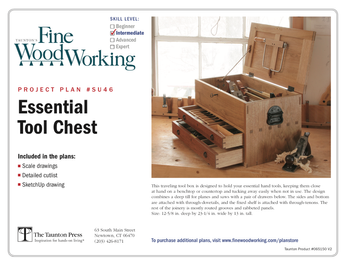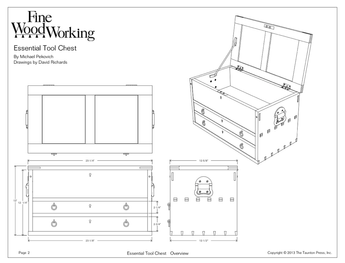I’d like to forego using a 1/4 inch plywood side panel thats called for on a furniture plan for a dresser I’m making. I prefer to make my own panels but have never made one this thin. Will a 1/4 inch solid wood panel be practical? Thanks, John
Discussion Forum
Get It All!
UNLIMITED Membership is like taking a master class in woodworking for less than $10 a month.
Start Your Free TrialCategories
Discussion Forum
Digital Plans Library
Member exclusive! – Plans for everyone – from beginners to experts – right at your fingertips.
Highlights
-
Shape Your Skills
when you sign up for our emails
This site is protected by reCAPTCHA and the Google Privacy Policy and Terms of Service apply. -
 Shop Talk Live Podcast
Shop Talk Live Podcast -
 Our favorite articles and videos
Our favorite articles and videos -
E-Learning Courses from Fine Woodworking
-
-
 Fine Woodworking New England Event
Fine Woodworking New England Event -












Replies
I'd want to use a raised panel if I went to solid wood. The look will be the same on the outside if the flat side is out and the raised side in. The draw back of solid wood is that it has to be allowed to float in the stiles and rails, while a plywood panel could be glued in to provide strength. That plywood strength should be necessary if the frame is well joined.
Edited 10/1/2007 12:00 am ET by SteveSchoene
I made solid pine, flat, door panels for a bathroom vanity a few years ago. Since I couldn't get 1/4" pine ply, I used 1/2" pine then used my raised panel back cutting bit to get the 1/4" thickness I needed for the rails & stiles.
From the front, it looks like standard flat panel doors. From the back, they look like raised panels.
Hello,
Last winter I resawed 6/4 red oak to make 3/8" thick panels for a stereo cabinet I was building for myself.
After resawing and watching the wood cup badly, off I went to the Planer to straighten it back out(I did wait a week 1st to see if it would come back).
Starting with about 9/16", I learnt alot about my planer and how tricky it is to flatten out wood. Every piece was a bit different to deal with but I finally prepared it for the planer.
Most of the boards were about 6" wide so I wanted to bookmatch them for my panels. Nice thin pieces of oak coming out of the planer looked wonderful.
Glueing up thin boards was another challenge but I survived. At this point I swore I would never do thin panels again.
But after I squared them off and pre oiled them and installed my first panel into the frame work, I was blown away by how nice the thin oak looked.
I finnished up with panels about 9mm thick.
Was it worth the time doing it this way to achieve small book matched panels? No, the next time I would just plane 3/4" boards down to get my final thickness, but it was a hell of an adventure!
Vance
I have made flat panels from solid wood many times. The basic procedures such as letting the wood aclimate are the same regardless of thickness. The only issue is to use cauls to keep the wood flat during glue up. Use wax paper between the wood and the cauls.
jpohja,
All the time! all the time!
I often go to my local sawmill and pick up thins.. thins are wood that mother nature threw in when she made the tree.
You see she's carelless and doesn't make trees to be sliced into even thicknesses, the left over get's sawn off first so boards wind up even and the center cant can be a marketable size.
I buy a pickup truck load of thins for $20.00. that's a tailgate dragging on the ground load with the springs pushed solidly up against the frame. headlights shooting for squrrils, load..
I get home and I sort according to thickness, 3/4 of an inch & over goes in one stack, 1/2 inch and over goes into another 1/4 inch and over the third stack.. less than 1/4 becomes kindling wood for fires.. (by the time it's dried and run thru a planner on both sides it is so thin you can read a newspaper thru it.. )
3/4 inch becomes wall panelling,, 1/2 becomes ceiling paneling, and 1/4 inch becomes a veneer.
A typical pickup load will do the average sized bedroom.
This forum post is now archived. Commenting has been disabled